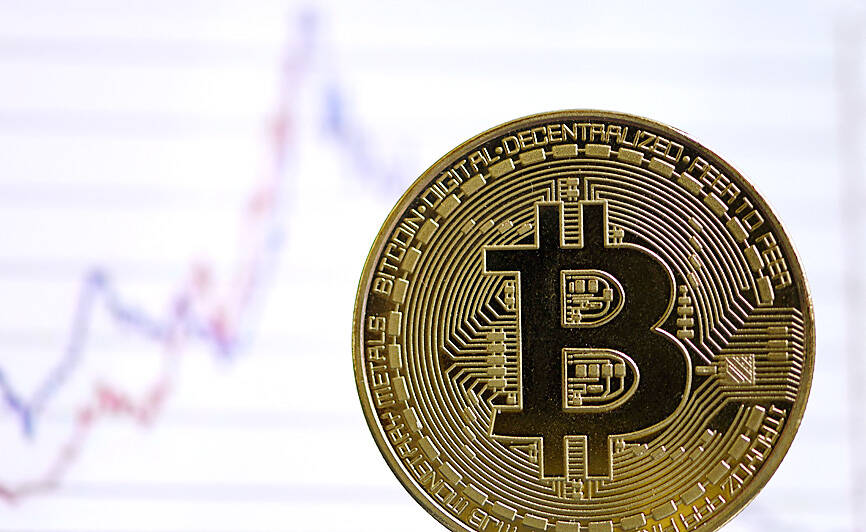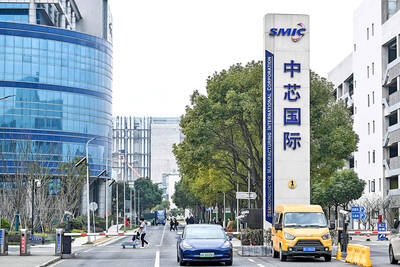Bitcoin yesterday was trading up more than 20 percent from last week’s lows, while several other cryptocurrencies that US President Donald Trump said would be included in a new US strategic reserve also rallied sharply.
Trump wrote in a post on Truth Social that his January executive order on digital assets would create a stockpile of currencies including bitcoin, ether, XRP, solana and cardano. The names had not previously been announced.
Bitcoin and ether would be at the heart of this reserve, he wrote on Sunday.

Photo: AFP
The post sent bitcoin, the world’s largest cryptocurrency, up by one-fifth from the November lows it was trading at on Friday, helping flip sentiment on a token that has been sliding since mid-January on disappointment Trump has not followed through on pledges to loosen regulation.
“Trump just gave the pump that crypto traders have been holding out for,” City Index Group senior analyst Matt Simpson said.
“Any faith that was lost last week appears to have been restored,” and new highs could be made unless there was another wave of risk-off selling, he said.
Chris Weston, research head at Australian online broker Pepperstone Group Ltd, said it was possible the rally would extend into the first White House Crypto Summit that Trump is to host on Friday, with the risk that the bearishness in other markets could weigh on sentiment.
While Wall Street closed higher on Friday, the recent sell-off in large technology bellwethers such as Nvidia Corp has eroded confidence in bitcoin, which some see as an alternative tech proxy.
Bitcoin fell more than 17 percent last month, clocking its biggest monthly percentage fall since June 2022 and losing more than one-third of its price since topping US$105,000 in early January.
Its rally since Trump’s election win in November last year was spurred by optimism that the crypto-friendly president would champion a strategic bitcoin fund and end the crackdown on the industry by the administration of former US president Joe Biden.
Beyond a flurry of appointments of crypto-friendly officials when Trump took office, there has been little concrete news so far around that policy for investors.

NO BREAKTHROUGH? More substantial ‘deliverables,’ such as tariff reductions, would likely be saved for a meeting between Trump and Xi later this year, a trade expert said China launched two probes targeting the US semiconductor sector on Saturday ahead of talks between the two nations in Spain this week on trade, national security and the ownership of social media platform TikTok. China’s Ministry of Commerce announced an anti-dumping investigation into certain analog integrated circuits (ICs) imported from the US. The investigation is to target some commodity interface ICs and gate driver ICs, which are commonly made by US companies such as Texas Instruments Inc and ON Semiconductor Corp. The ministry also announced an anti-discrimination probe into US measures against China’s chip sector. US measures such as export curbs and tariffs

The US on Friday penalized two Chinese firms that acquired US chipmaking equipment for China’s top chipmaker, Semiconductor Manufacturing International Corp (SMIC, 中芯國際), including them among 32 entities that were added to the US Department of Commerce’s restricted trade list, a US government posting showed. Twenty-three of the 32 are in China. GMC Semiconductor Technology (Wuxi) Co (吉姆西半導體科技) and Jicun Semiconductor Technology (Shanghai) Co (吉存半導體科技) were placed on the list, formally known as the Entity List, for acquiring equipment for SMIC Northern Integrated Circuit Manufacturing (Beijing) Corp (中芯北方積體電路) and Semiconductor Manufacturing International (Beijing) Corp (中芯北京), the US Federal Register posting said. The

India’s ban of online money-based games could drive addicts to unregulated apps and offshore platforms that pose new financial and social risks, fantasy-sports gaming experts say. Indian Prime Minister Narendra Modi’s government banned real-money online games late last month, citing financial losses and addiction, leading to a shutdown of many apps offering paid fantasy cricket, rummy and poker games. “Many will move to offshore platforms, because of the addictive nature — they will find alternate means to get that dopamine hit,” said Viren Hemrajani, a Mumbai-based fantasy cricket analyst. “It [also] leads to fraud and scams, because everything is now

MORTGAGE WORRIES: About 34% of respondents to a survey said they would approach multiple lenders to pay for a home, while 29.2% said they would ask family for help New housing projects in Taiwan’s six special municipalities, as well as Hsinchu city and county, are projected to total NT$710.65 billion (US$23.61 billion) in the upcoming fall sales season, a record 30 percent decrease from a year earlier, as tighter mortgage rules prompt developers to pull back, property listing platform 591.com (591新建案) said yesterday. The number of projects has also fallen to 312, a more than 20 percent decrease year-on-year, underscoring weakening sentiment and momentum amid lingering policy and financing headwinds. New Taipei City and Taoyuan bucked the downturn in project value, while Taipei, Hsinchu city and county, Taichung, Tainan and Kaohsiung